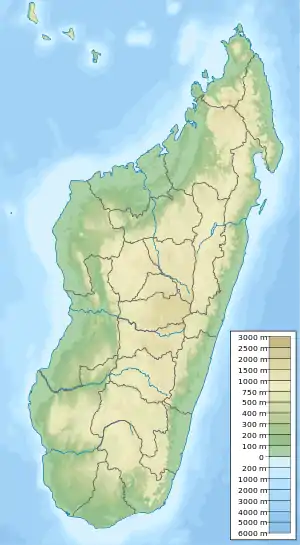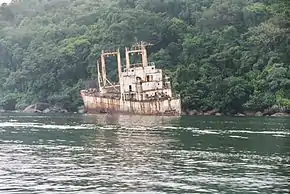Nosy Mangabe
Nosy Mangabe is a small island reserve located in Antongil Bay about 2 km offshore from the town of Maroantsetra in north-east Madagascar. it is accessible by small boat and is part of the larger Masoala National Park complex. It is a tropical rainforest preserve and sanctuary for a species of lemur, the aye-aye (Daubentonia madagascariensis). It lies close enough to Maroantsetra for a day trip, although an overnight stay is recommended for seeing the nocturnal aye-aye.
| Nosy Mangabe Reserve | |
|---|---|
IUCN category IV (habitat/species management area) | |
 Location of Nosy Mangabe Reserve | |
| Location | North-east Madagascar |
| Nearest city | Maroantsetra |
| Coordinates | 15°30′S 49°46′E |
| Area | 5.2 km² |
| Established | 1965 |
| Visitors | approx. 3000 (in 2005) |
| Governing body | Madagascar National Parks Association (ANGAP) in partnership with the Wildlife Conservation Society |
History
The island has a rich history of trading and piracy and on the west side of the island are rock carvings by Dutch sailors from the 16th-century. In the 17th-century the area was invaded by the French who established a trading post.[1] British science fiction writer Douglas Adams visited the island searching for the aye-aye, for a radio programme and in one of his lesser known books, Last Chance to See.[2]
Geography
Nosy Mangabe is a 520 hectares (1,300 acres) island nature reserve in Antongil Bay in the north-east of Madagasgar. The island is covered in dense forest, has an altitude of 1,331 metres (4,367 ft) and the annual rainfall is 4,000 millimetres (160 in). It is part of the Masoala National Park. There are no permanent settlements on the island; a campsite with bathroom and kitchen facilities serves as a base camp for biologists, researchers and eco-tourists. The best way to see the island is by boat from Maroansetra, which takes about 45 minutes.[3]
Flora and fauna
The island is covered in dense humid forest and was established as a reserve for the aye-aye which were introduced to the island in the 1960s. They were in danger of extinction, having been hunted, for centuries, by local people who consider them to be a symbol of death and harbinger of evil.[1] They are categorised as endangered by the International Union for Conservation of Nature (IUCN).[4] There are a further four species of lemur on the island; the eastern woolly lemur (Avahi laniger), white-fronted lemur (Eulemur albifrons), black-and-white ruffed lemur (Varecia variegata) and gray mouse-lemur (Microcebus murinus).[5]
Baron’s climbing rosewood (Dalbergia baronii) is a vulnerable tree found on the island.[3]

References
- "Nosy Mangabe Special Reserve". Retrieved 26 October 2016.
- Adams, Douglas; Carwardine, Mark (2009). Last Chance To See. Arrow. ISBN 978-0099536796.
- "Nosy Mangabe Special Reserver". Madagaskar.org. Archived from the original on 2 July 2016. Retrieved 26 October 2016.
- "Daubentonia madagascariensis". IUCN redlist. Retrieved 26 October 2016.
- "Nosy Mangabe". WildMadagascar.org. Retrieved 26 October 2016.
